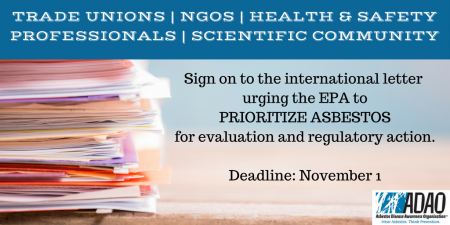ADAO is facilitating an international joint letter from Trade Unions, NGOs, Health & Safety Professionals, and the Scientific Community urging the EPA to prioritize asbestos on the the 2016 top ten high-risk chemical list for evaluation and regulatory action. The EPA must announce these top ten high-risk chemicals on or before December 22, 2016.
We are at the edge of achieving a great victory: The Frank R. Lautenberg Chemical Safety for the 21st Century Act was signed into law (H.R.2576), which ensures the US Environmental Protection Agency (EPA) can finally evaluate and prohibit asbestos imports and use in the United States. What’s more, just weeks after ADAO wrapped a successful week of TSCA implementation briefings and meetings with Congress and the EPA, U.S. Senator Barbara Boxer introduced The Alan Reinstein Ban Asbestos Now Act of 2016 (S.3427), which would achieve an asbestos ban in 18 months instead of 5-7 years. Between upcoming TSCA implementation and Boxer’s bill, we now have two clear paths to ban asbestos. This is the closest we’ve been — ever!
Your participation in working toward our shared goals is crucial! To sign on, please complete the Google Form by November 1, 2016, as this letter will be hand delivered to the EPA.
DRAFT LETTER
Dear Administrator McCarthy,
On behalf of leading international trade unions, public health, and environmental individuals and organizations, we urge you to prioritize asbestos as one of the 2016 top ten high-risk chemicals for evaluation under TSCA, leading toward the prohibition of asbestos in manufacturing, processing, use, distribution in commerce, and disposal.
According to the World Health Organization (WHO), “All types of asbestos cause lung cancer, mesothelioma, cancer of the larynx and ovary, and asbestosis (fibrosis of the lungs),” and further, that “there is no safe level of exposure.”
Asbestos remains the poster child for the failure of the 1976 Toxic Substances Control Act (TSCA) and now stands as the litmus test for the success and efficacy of The Frank R. Lautenberg Chemical Safety for the 21st Century Act. As we both heard, President Obama became the first sitting U.S. president to publicly acknowledge the dangers of asbestos: “the system was so complex, it was so burdensome, that our country hasn’t even been able to uphold a ban on asbestos—a known carcinogen that kills as many as 10,000 Americans every year. I think a lot of Americans would be shocked by all that.”
The facts are irrefutable. In 1971, the Environmental Protection Agency (EPA) identified asbestos as a hazardous pollutant. That same year, the Occupational Safety and Health Administration (OSHA) and the National Institute for Occupational Safety and Health (NIOSH) jointly created the first standard for regulating asbestos exposure. In 1973, the EPA banned spray-applied asbestos-containing material for fireproofing and insulating purposes. And in 1976, the International Agency for Research on Cancer (IARC) listed asbestos as a human carcinogen, and NIOSH called for a ban on asbestos in U.S. workplaces.
The United States and Canada are the only two Western industrialized nations not to ban asbestos.
More than 55 countries have banned asbestos and now use economically viable safer substitutes, yet the United States Geological Survey (USGS) reported that in 2015, the U.S. imported 358 metric tons of asbestos “to meet manufacturing needs.” In fact, the chlor-alkali industry alone accounted for an estimated 90% of U.S. asbestos consumption and wants to continue its use despite the public health repercussions.
We are encouraged by your June 22, 2016 statement: “The updated law gives EPA the authorities we need to protect American families from the health effects of dangerous chemicals.” More than 200,000 Americans have died from preventable asbestos-caused diseases since the EPA’s failed 1989 attempt at an asbestos ban and imports have continued. Protection from this deadly mineral is something all Americans desperately need, and we can’t afford to wait any longer.
There is consensus. In addition to Senators Boxer, Tester, Feinstein, and Durbin writing open letters to the EPA, urging you to prioritize asbestos as you implement TSCA, leading organizations such as National Resources Defense Council (NRDC); the American Public Health Association (APHA); the Environmental Information Association (EIA); and Safer Chemicals, Healthy Families (SCHF); Environmental Working Group (EWG); Collegium Ramazzini (CR); and the Asbestos Disease Awareness Organization (ADAO) are in agreement that asbestos must be named on or before December 22, 2016.
We, the below signatories, urge the EPA to prioritize asbestos as one of the first 2016 ten high-risk chemicals for evaluation and regulatory action. The time is now to protect public health and the environment.
Sincerely,

